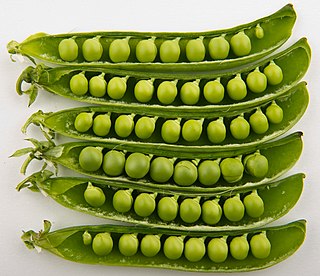
The pea is most commonly the small spherical seed or the seed-pod of the pod fruit Pisum sativum. Each pod contains several peas, which can be green or yellow. Botanically, pea pods are fruit, since they contain seeds and develop from the ovary of a (pea) flower. The name is also used to describe other edible seeds from the Fabaceae such as the pigeon pea, the cowpea, and the seeds from several species of Lathyrus.
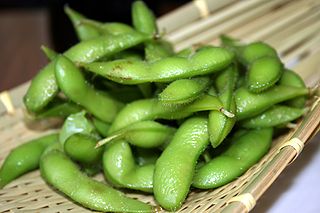
Edamame is a preparation of immature soybeans in the pod, found in cuisines with origins in East Asia. The pods are boiled or steamed and may be served with salt or other condiments. In Japan, they are usually blanched in 4% salt water and not served with salt. When the beans are outside the pod, the term mukimame is also sometimes used in Japanese.

The radish is an edible root vegetable of the family Brassicaceae that was domesticated in Asia prior to Roman times.

Vegetable sandwich is a type of vegetarian sandwich consisting of a vegetable filling between bread. There are no set requirements other than the use of vegetables, and sandwiches may be toasted or untoasted. Vegetable sandwiches are served throughout the world and are a popular street food in India.
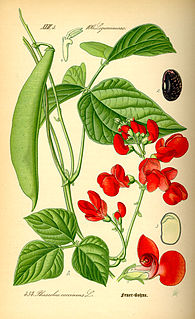
Phaseolus coccineus, known as runner bean, scarlet runner bean, or multiflora bean, is a plant in the legume family, Fabaceae. Another common name is butter bean, which, however, can also refer to the lima bean, a different species.
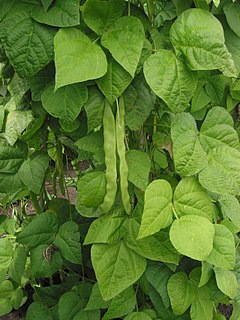
Phaseolus vulgaris, also known as the common bean and French bean, is a herbaceous annual plant grown worldwide for its edible dry seeds or unripe fruit. The main categories of common beans, on the basis of use, are dry beans, snap beans and shell (shelled) beans. Its leaf is also occasionally used as a vegetable and the straw as fodder. Its botanical classification, along with other Phaseolus species, is as a member of the legume family Fabaceae. Like most members of this family, common beans acquire the nitrogen they require through an association with rhizobia, which are nitrogen-fixing bacteria.
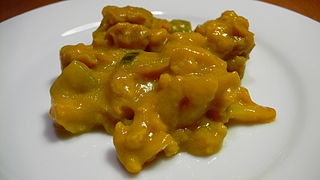
Piccalilli, or mustard pickle, is a British interpretation of South Asian pickles, a relish of chopped, pickled, vegetables and spices. Regional recipes vary considerably.

Choy sum is a leafy vegetable commonly used in Chinese cuisine. It is a member of the genus Brassica of the mustard family, Brassicaceae. Choy sum is a transliteration of the Cantonese name, which can be literally translated as "heart of the vegetable". It is also known as Chinese flowering cabbage.

The asparagus bean is a legume cultivated for its edible green pods containing immature seeds, like the green bean. It is also known as the yardlong bean, long-podded cowpea, Chinese long bean, bodi/bora, snake bean, or pea bean. Despite the common name of "yardlong", the pods are actually only about half a yard long, so the subspecies name sesquipedalis is a more accurate approximation.

Green beans are the unripe, young fruit of various cultivars of the common bean. Immature or young pods of the runner bean, yardlong bean, and hyacinth bean are used in a similar way. Green beans are known by many common names, including French beans, string beans, snap beans, snaps, and the French name haricot vert. They are also known as Baguio beans in Philippine English, to distinguish them from yardlong beans. Other locals in the vegetable farming regions of the Philippines refer these as "habitchuelas". It is commonly grown in the northern highlands of Benguet, Mountain Province and Nueva Vizcaya, and other mid-elevation areas in the country like Bukidnon, Quezon and Laguna.
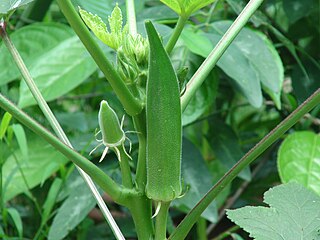
Okra or Okro, Abelmoschus esculentus, known in many English-speaking countries as ladies' fingers or ochro, is a flowering plant in the mallow family. It is valued for its edible green seed pods. The geographical origin of okra is disputed, with supporters of West African, Ethiopian, and South Asian origins. The plant is cultivated in tropical, subtropical and warm temperate regions around the world.

Parkia speciosa is a plant of the genus Parkia in the family Fabaceae. It bears long, flat edible beans with bright green seeds the size and shape of plump almonds which have a rather peculiar smell, similar to, but stronger than that of the shiitake mushroom, due to sulfur-containing compounds also found in shiitake, truffles and cabbage.

Moringa oleifera is a fast-growing, drought-resistant tree of the family Moringaceae, native to the Indian subcontinent. Common names include moringa, drumstick tree, horseradish tree, and ben oil tree or benzolive tree.

Undhiyu is a Gujarati mixed vegetable dish that is a regional specialty of Surat, Gujarat, India. The name of this dish comes from the Gujarati word "undhu", which translates to upside down, since the dish is traditionally cooked upside down underground in earthen pots, termed "matlu", which are fired from above.
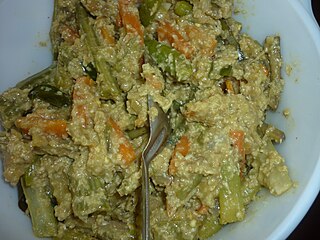
Avial is a dish which originated from Tamilnadu, although it is equally popular in South Canara region of Karnataka and Kerala. It is a thick mixture of 13 vegetables commonly found in the western ghats and coconut, seasoned with coconut oil and curry leaves. Avial is considered an essential part of the Main meal (Oonu in Malayalam
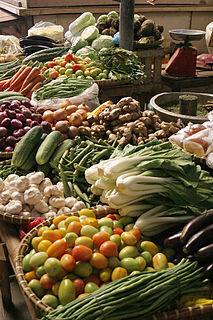
Vegetables are parts of plants that are consumed by humans or other animals as food. The original meaning is still commonly used and is applied to plants collectively to refer to all edible plant matter, including the flowers, fruits, stems, leaves, roots, and seeds. The alternate definition of the term is applied somewhat arbitrarily, often by culinary and cultural tradition. It may exclude foods derived from some plants that are fruits, flowers, nuts, and cereal grains, but include savoury fruits such as tomatoes and courgettes, flowers such as broccoli, and seeds such as pulses.

Sayur asem or sayur asam is an Indonesian vegetable soup. It is a popular Southeast Asian dish originating from Sundanese cuisine, consisting of vegetables in tamarind soup.

The snow pea is an edible-pod pea with flat pods and thin pod walls. It is eaten whole, with both the seeds and the pod, while still unripe.

Chicken Lahori is a Pakistani curry which originated in Lahore. Served with basmati rice. It is a popular street food in Lahore.



















